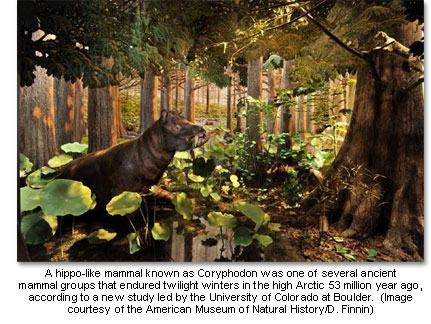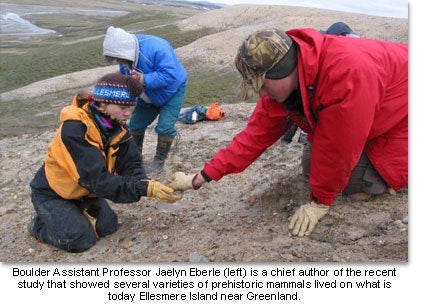Study: ancient Arctic mammals wintered in darkness
 A new study led by the University of Colorado at Boulder sheds light on the day-to-day lives of ancient mammals that roamed the Arctic Circle some 53 million years ago. The mammals, which weighed up to 1,000 pounds each, were the ancestors of tapirs and ancient cousins of rhinos, and lived on what is today Ellesmere Island near Greenland.
A new study led by the University of Colorado at Boulder sheds light on the day-to-day lives of ancient mammals that roamed the Arctic Circle some 53 million years ago. The mammals, which weighed up to 1,000 pounds each, were the ancestors of tapirs and ancient cousins of rhinos, and lived on what is today Ellesmere Island near Greenland.
In the study, CU-Boulder Assistant Professor Jaelyn Eberle concludes that the animals lived in lush, swampy forests and endured six months of darkness each year. In summer, they ate flowering plants, deciduous leaves and aquatic vegetation. In winter's twilight, they dined on twigs, leaf litter, evergreen needles and fungi.
Assistant Professor Jaelyn Eberle working in the field"We were able to use carbon signatures preserved in the tooth enamel to show that these mammals did not migrate or hibernate," said Eberle, curator of fossil vertebrates at the CU Museum of Natural History and chief study author. "Instead, they lived in the high Arctic all year long, munching on some unusual things during the dark winter months."
The findings of the study, which Eberle co-authored with Henry Fricke of Colorado College in Colorado Springs and John Humphrey of the Colorado School of Mines in Golden, will appear in the June issue of the journal Geology.
The National Science Foundation-funded research has implications for the dispersal of early mammals across polar land bridges into North America and for modern mammals that likely will begin moving north if Earth's climate continues to warm.


